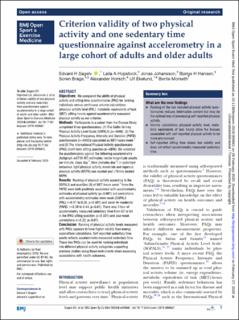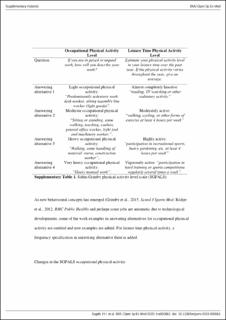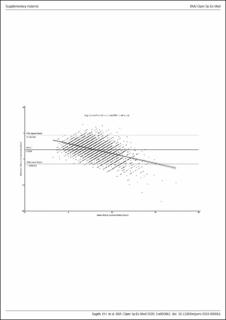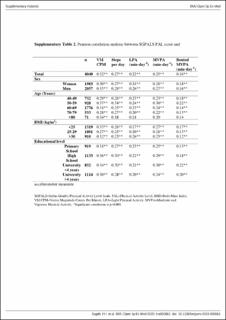| dc.contributor.author | Sagelv, Edvard Hamnvik | |
| dc.contributor.author | Hopstock, Laila Arnesdatter | |
| dc.contributor.author | Johansson, Jonas | |
| dc.contributor.author | Hansen, Bjørge Herman | |
| dc.contributor.author | Søren, Brage | |
| dc.contributor.author | Horsch, Alexander | |
| dc.contributor.author | Ekelund, Ulf | |
| dc.contributor.author | Morseth, Bente | |
| dc.date.accessioned | 2021-03-19T00:09:43Z | |
| dc.date.available | 2021-03-19T00:09:43Z | |
| dc.date.created | 2020-02-27T14:13:12Z | |
| dc.date.issued | 2020 | |
| dc.identifier.citation | BMJ Open Sport & Exercise Medicine. 2020, 6(1), Artikkel e000661. | en_US |
| dc.identifier.issn | 2055-7647 | |
| dc.identifier.uri | https://hdl.handle.net/11250/2734328 | |
| dc.description | This is an open access article distributed in accordance with the Creative Commons Attribution Non Commercial (CC BY-NC 4.0) license, which permits others to distribute, remix, adapt, build upon this work non-commercially, and license their derivative works on different terms, provided the original work is properly cited, appropriate credit is given, any changes made indicated, and the use is non-commercial. | en_US |
| dc.description.abstract | Objectives: We compared the ability of physical activity and sitting time questionnaires (PAQ) for ranking individuals versus continuous volume calculations (physical activity level (PAL), metabolic equivalents of task (MET), sitting hours) against accelerometry measured physical activity as our criterion.
Methods: Participants in a cohort from the Tromsø Study completed three questionnaires; (1) The Saltin-Grimby Physical Activity Level Scale (SGPALS) (n=4040); (2) The Physical Activity Frequency, Intensity and Duration (PAFID) questionnaire (n=5902)) calculated as MET-hours·week-1 and (3) The International Physical Activity questionnaire (IPAQ) short-form sitting question (n=4896). We validated the questionnaires against the following accelerometry (Actigraph wGT3X-BT) estimates: vector magnitude counts per minute, steps∙day-1, time (minutes·day-1) in sedentary behaviour, light physical activity, moderate and vigorous physical activity (MVPA) non-bouted and ≥10 min bouted MVPA.
Results: Ranking of physical activity according to the SGPALS and quartiles (Q) of MET-hours∙week-1 from the PAFID were both positively associated with accelerometry estimates of physical activity (p<0.001) but correlations with accelerometry estimates were weak (SGPALS (PAL): r=0.11 to 0.26, p<0.001) and weak-to-moderate (PAFID: r=0.39 to 0.44, p<0.01). There was 1 hour of accelerometry measured sedentary time from Q1 to Q4 in the IPAQ sitting question (p<0.001) and also weak correlations (r=0.22, p<0.01).
Conclusion: Ranking of physical activity levels measured with PAQs appears to have higher validity than energy expenditure calculations. Self-reported sedentary time poorly reflects accelerometry measured sedentary time. These two PAQs can be used for ranking individuals into different physical activity categories supporting previous studies using these instruments when assessing associations with health outcomes. | en_US |
| dc.language.iso | eng | en_US |
| dc.subject | physical activity | en_US |
| dc.subject | sitting time questionnaires | en_US |
| dc.subject | PAQ | en_US |
| dc.subject | PAL | en_US |
| dc.subject | MET | en_US |
| dc.subject | accelerometry | en_US |
| dc.title | Criterion validity of two physical activity and one sedentary time questionnaire against accelerometry in a large cohort of adults and older adults | en_US |
| dc.type | Peer reviewed | en_US |
| dc.type | Journal article | en_US |
| dc.description.version | publishedVersion | en_US |
| dc.rights.holder | © Author(s) (or their employer(s)) 2020 | en_US |
| dc.source.pagenumber | 7 | en_US |
| dc.source.volume | 6 | en_US |
| dc.source.journal | BMJ Open Sport & Exercise Medicine | en_US |
| dc.source.issue | 1 | en_US |
| dc.identifier.doi | 10.1136/bmjsem-2019-000661 | |
| dc.identifier.cristin | 1798159 | |
| dc.description.localcode | Institutt for idrettsmedisinske fag / Department of Sports Medicine | en_US |
| dc.source.articlenumber | e000661 | en_US |
| cristin.ispublished | true | |
| cristin.fulltext | original | |
| cristin.qualitycode | 1 | |



